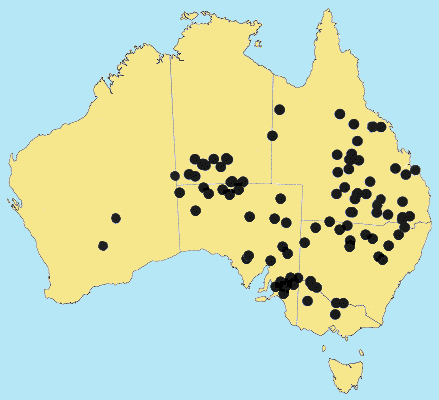Digitaria ammophila (Benth.) D. K.
Hughes. Bull. Misc. Inform. 313 (1923).
Classification.
(GPWG 2001) : Subfamily Panicoideae. Paniceae.
Basionym and/or
Replacement Name: Panicum
ammophilum F. Muell., Trans. & Proc. Victorian Inst. Advancem. Sci. 1:
46 (1855), non Steud. (1854).
Type of Basionym or
Protologue Information: HT: Mueller s.n., Dec 1858, Australia: on sandhills along the Murray River (MEL; IT: K).
Recent synonyms:
D. ammophila var. macrolepis.
Key references
(books and floras): [1952] C.A.Gardner, Flora of Western Australia 1
Gramineae (230), [1981] M.Lazarides in J.Jessop (ed)., Flora of
Central Australia (473), [2002] D.Sharp & B.K.Simon, AusGrass,
Grasses of Australia, [2006] J.Jessop, G.R.M.Dashorst, F.M.James, Grasses
of South Australia (438), [2008] S.W.L.Jacobs, R.D.B.Walley &
D.J.B.Wheeler, Grasses of New South Wales (214).
Illustrations:
[2006] J.Jessop, G.R.M.Dashorst, F.M.James, Grasses of South Australia (438, Fig. 368), [2008] S.W.L.Jacobs,
R.D.B.Whalley & D.J.B.Wheeler, Grasses of New South Wales, 4th edn
(214).
Habit. Perennial. Rhizomes present. Stolons absent. Culms erect or
geniculately ascending, 15–60 cm tall, 2–5 -noded. Mid-culm internodes
glabrous. Mid-culm nodes glabrous or pubescent. Lateral branches sparsely
branched. Leaf-sheaths hairy. Leaf-sheath auricles absent. Ligule an eciliate
membrane, 1–3 mm long, erose, obtuse. Leaf-blades flat, 4–20 cm long, 3–7.5 mm
wide. Leaf-blade surface smooth, indumented.
Inflorescence.
Inflorescence subdigitate, with racemose branches. Racemes 5–15, spreading,
flexuous, 10–20 cm long. Central inflorescence axis 0.1–0.3 cm long.
Spikelets.
Spikelets pedicelled, 2 in the cluster. Fertile spikelets 2-flowered, the lower
floret barren (rarely male), the upper fertile, comprising 1 basal sterile
florets, comprising 1 fertile floret(s), without rachilla extension, elliptic,
dorsally compressed, 1.8–2.9 mm long. Rhachilla internodes elongated between
glumes.
Glumes. Glumes
thinner than fertile lemma. Lower glume ovate, membranous, 0 -nerved. Upper
glume elliptic, 1.8–2.8 mm long, membranous, without keels, 3 -nerved. Upper
glume surface indumented. Florets. Basal sterile florets 1, barren,
without significant palea. Lemma of lower sterile floret 100 % of length of
spikelet, membranous, 5–7 -nerved.
Fertile lemma 1.8–2.8
mm long, without keel. Lodicules present.
Continental Distribution:
Australasia.
Australian
Distribution: Western Australia, Northern Territory, South Australia,
Queensland, New South Wales, Victoria.
Western Australia: Helms. Northern Territory: Central
Australia South. South Australia:
North-western, Lake Eyre, Flinders Ranges, Eastern, Murray, Southern Lofty. Queensland:
Burke, Darling Downs, Gregory North, Maranoa,
Mitchell, North Kennedy, Port Curtis, South Kennedy, Warrego. New South
Wales: North-Western Slopes, North-Western Plains, South-Western Plains,
North Far Western Plains. Victoria:
Midlands, Murray
Mallee, Riverina, Wimmera.
Notes. In
semi-arid shrub woodlands, shrub steppe shrublands, acacia shrublands, eucalypt
shrublands, and arid tussock grasslands. A widespread variable species.
Important as a forage grass in drier areas. Flowers mostly Feb.-Apr.




